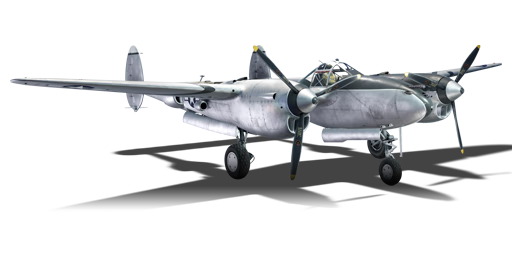



The P-38L-5-LO is an American twin-engine fighter. It was introduced in Update 1.53 "Firestorm".
The P-38 Lightning is to be played primarily as an Air Superiority fighter. Boom & Zoom tactics are one of your greatest assets in this aircraft. By using your powerful armament, high speed, good manoeuvrability, and good climb rate, in the hands of a skilled pilot, a P-38L is one of the greatest threats to an entire team.
The P-38L is the last Lightning in the US Aviation tech tree that can be researched. This plane has some of the same defining factors of prior models of the Lightning but with greater modifications to make this variant of the P-38 among the best planes in the game. The biggest upgrade over the P-38J-15 is the presence of air brakes on the P-38L, which means you can pull out of a dive much easier than in any other prior model. In addition, you also can research the "New Boosters" module, which greatly improves your roll rate.
flaps
flaps
flaps
brake
| Belt | Belt filling | Armor penetration (mm) at a distance: | |||||
|---|---|---|---|---|---|---|---|
| 10 m | 100 m | 500 m | 1000 m | 1500 m | 2000 m | ||
| HEF-I/AP-T | 39 | 36 | 25 | 16 | 10 | 6 | |
| AP-T/AP-T/HEF-I/HEF-I | 39 | 36 | 25 | 16 | 10 | 6 | |
| HEF-I/HEF-I/HEF-I/AP-T | 39 | 36 | 25 | 16 | 10 | 6 | |
| AP-T/AP-T/AP-T/HEF-I | 39 | 36 | 25 | 16 | 10 | 6 | |
| HEF-I | 5 | 4 | 3 | 2 | 2 | 2 | |
| Belt | Belt filling | Armor penetration (mm) at a distance: | |||||
|---|---|---|---|---|---|---|---|
| 10 m | 100 m | 500 m | 1000 m | 1500 m | 2000 m | ||
| API-T/AP/AP/I | 30 | 27 | 20 | 13 | 9 | 6 | |
| AP-I/AP-I/API-T/I/I | 28 | 26 | 18 | 11 | 7 | 4 | |
| API-T/I/AP/AP/AP-I/AP-I | 30 | 27 | 20 | 13 | 9 | 6 | |
| API-T | 28 | 26 | 18 | 11 | 7 | 4 | |
| AP-I/I/AP-I/I | 28 | 26 | 18 | 11 | 7 | 4 | |












Flight performance | |
|---|---|
Survivability |
|---|
Weaponry | |
|---|---|